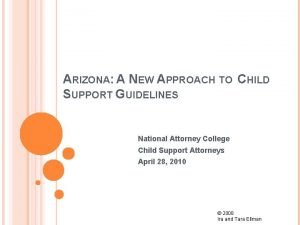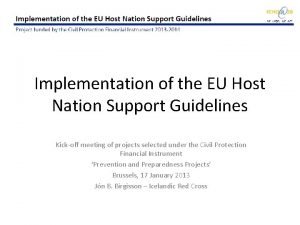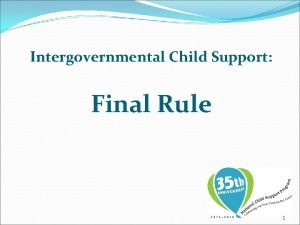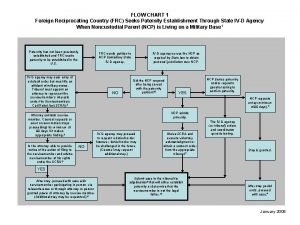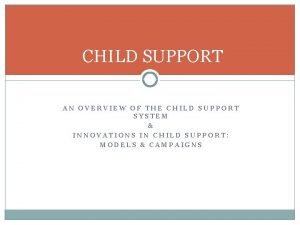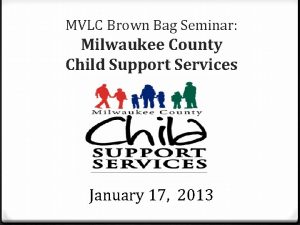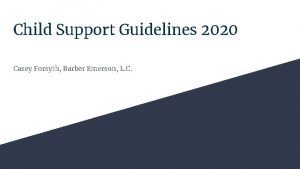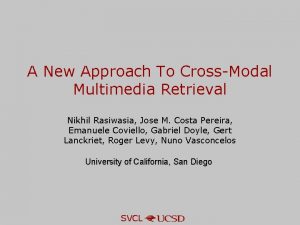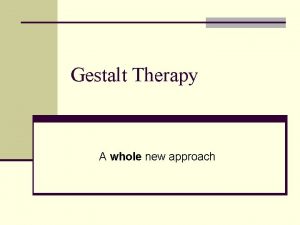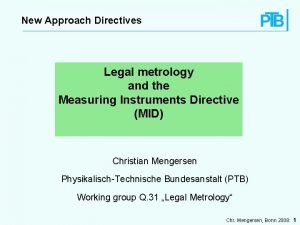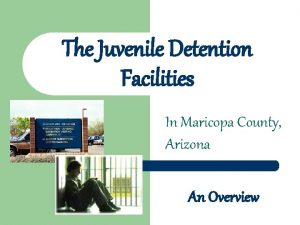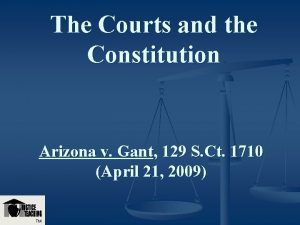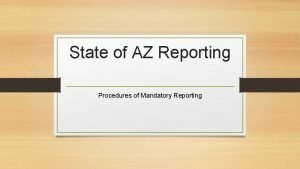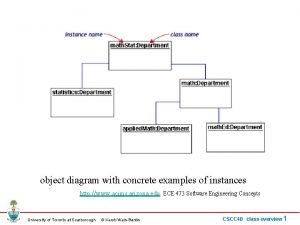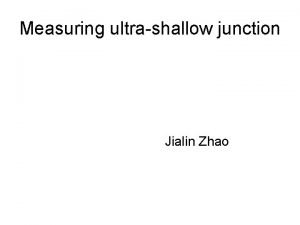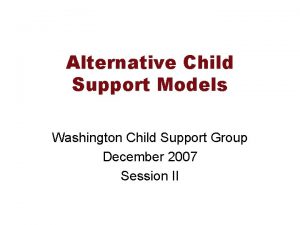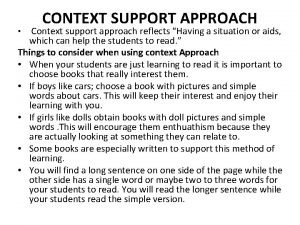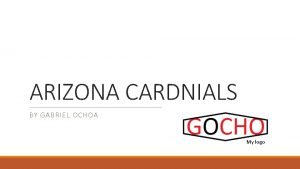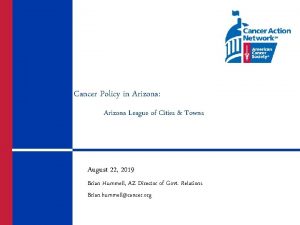ARIZONA A NEW APPROACH TO CHILD SUPPORT GUIDELINES














































- Slides: 46

ARIZONA: A NEW APPROACH TO CHILD SUPPORT GUIDELINES National Attorney College Child Support Attorneys April 28, 2010 © 2008 Ira and Tara Ellman

PRESENTATION OVERVIEW: 3 PARTS What Are Support Guidelines Supposed to Do? What Do? Do Most States Actually What Do Arizona’s New Guidelines Do? Note on usage: Dad and Mom, or NCP and CP 2

WHAT GUIDELINES ARE SUPPOSED TO DO Who tells us what they are supposed to do? � Scholars � Empirical Studies of Citizens Views They Agree There Are Multiple Goals � Ensure Child A Decent Minimum if at all possible � Provide Child More if possible: avoid gross disparities � Vindicate the Principle that Both Parents Pay � Respect the Obligor’s Claim on His Own Earnings For poor obligors, the self support reserve For wealthier obligors, retain some advantage But: what does the Law say guidelines should do? 3

A. R. S. § 25 -320(D) The supreme court shall base the guidelines and criteria for deviation from them on all relevant factors, including: 4

A. R. S. § 25 -320(D), continued 1. The financial resources and needs of the child. 2. The financial resources and needs of the custodial parent. 3. The standard of living the child would have enjoyed had the marriage not been dissolved. 4. The physical and emotional condition of the child, and the child's educational needs. 5

A. R. S. § 25 -320(D), continued Post grid addon 5. The financial resources and needs of the noncustodial parent. 6. The medical support plan for the child. 7. Excessive or abnormal expenditures, destruction, concealment or fraudulent disposition of community, joint tenancy and other property held in common. 8. The duration of parenting time and related expenses. Final calculation within the grid 6

THUS: FOUR STATUTORY CRITERIA 1. The financial resources and needs of the child. Compare: a) the 2 2. The financial resources and postseparation needs of the custodial parent. households to one 3. The financial resources and another needs of the noncustodial parent. b) Their earlier situation when the family was intact 4. The standard of living the child would have enjoyed had the marriage not been dissolved. 7

PART I CONCLUSION AND QUESTIONS Guideline amounts always reflect tradeoffs among competing goals The goals are set by statutes and cases Meeting the goals requires comparing the postseparation living standards of the two resulting households to each other, and to the pre-separation household These required comparisons tell you the kind of economic data the guideline writer needs Question: are current guidelines based on this kind of data? 9

PRESENTATION OVERVIEW: 3 PARTS What Are Support Guidelines Supposed to Do? What Do Most States Actually Do? What Will the New Arizona Guidelines Do? 10

Guideline Basics POOI vs. Income Shares � Both Set Support as a Percentage of Parental Income – POOI to obligor income only � Income Shares Applies the percentage to total parental income Then requires Dad to pay his proportionate share Arizona—and most states--are Income Shares The 2 systems give same result if they use the same percentages: � Example: 20%, Dad $1000, � Child support is $200 either Mom $500 way The real difference between the 2 systems: they use different percentages 11

CHART 2 SUPPORT RATES High Rates at Low Incomes Total support obligation divided by combined income Low Rates at High Incomes (The support rate Dad pays on his income depends on the parents’ combined income. ) 12

Arizona & Wisconsin Rates, 2 Children 13

Where The Percentages Don’t Come From: (Guideline Myths) Not estimates of the cost of raising a child � Can’t be, because there is no single measure of that cost � The cost depends on the living standard you want to buy for the child Is it an estimate of the cost of providing child with the marital living standard? � Can’t be—too high, not usually practical or possible An estimate of the cost of providing some lesser living standard that reflects a balancing of the goals set forth in the typical statute? � � That would be an appropriate measure But numbers in typical guideline not based on that either So then—where do they come from? 14

WHERE THEY DO COME FROM Derived from Estimates of what � The average intact family � With the same parental incomes as the divorcing parents � And the same household composition � Spends on their children Income Shares and POOI usually employ different methods for estimating these expenditures � POOI method yields a percentage that does not vary much with parental income � Income Shares method yields percentages that decline steeply as parental income rises The declining percent yields regressive rate for Dads 15

o To estimate expenditures on children one must first define them: what counts as an expenditure on children? o If the goal is to compare the child’s situations during marriage and after separation, then we want to count expenditures that benefit the child (“benefiting expenditures”) What Do Current Methods Measure? �Marginal expenditures on the child These 2 expenditure measures very different 16

What Are the Marginal Expenditures? * *Illustrative (not actual data) Point: Child Benefits from Base Expenditures Because of Joint Consumption But the Support System Only Allocates Marginal Expenditures 17

Impact of Basing Support Amounts on Marginal Expenditure Assume two intact families � Total Parental Income is $3000 in both � Both consist of two parents and one child Assume marginal expenditures on the child are $589, or 19. 6% of parental income. � This is rate in Arizona for this case. Family 1: Equal Earning Parents Family 2: Dad earns $2500, Mom $500 18

Family 1: (Equal Earners) � Each parent responsible for half of $589, or $295 � Mom + child have $1500 + $295 = $1795 � Dad has $1500 - $295 = $1205 � Both worse off, but probably about equally worse off Family 2: (Dad earns $2500, Mom $500) � Dad’s share of the $589 is 5/6, or $491 � Mom and child have $500 + $491 = $991 � Dad has $2500 - $491 = $2009. � Dad is doing fine, Mom and child in deep DD Conclusion � Two children start out the same, � But end up in very different situations. 19

Why Marginal Expenditure Measure Yields This Result What happens when one parent earns much more than the other? � The low-income Mom who receives Dad’s share of the marginal expenditure can now afford the extra bedroom—but not the kitchen or bathroom � The low-income Dad must make burdensome payments to a Mom who already lives better than he does Current system works when parents are equal earners, but not when earnings are disparate 20

Conclusion: Two Problems With Current Guidelines One: Based on Marginal Expenditures � Bad for Low Income Parent, Mom or Dad � Few state guideline committee even aware that this is basis. � It is hidden in the technical choices of the economic consultants who write most guidelines Two: Regressive Rate Structure (Income Shares) � Exacerbates problem when there are disparate incomes � Arises in part from questionable data used to estimate marginal expenditures for income shares guidelines 21

PART II: OVERALL CONCLUSIONS Most current guidelines are created by a method that is not based on statutory criteria � Statutory criteria typically focus on Outcomes, not marginal expenditures in intact families What would be better? A method allowing the guideline writer to � Assess Outcomes that result from any proposed support schedule, so as to � Establish support amounts that make the appropriate tradeoffs among the statutory criteria Arizona developed this model: Child Outcome Based Support (COBS) 22

PRESENTATION OVERVIEW : 3 PARTS What Are Support Guidelines Supposed to Do? What Do They Actually Do? What Will the New Arizona Guidelines Do? 23

The Proposed Arizona System: COBS (Child-Outcome Based Support) Guideline Amounts are based on outcome measures These outcome measure allow the committee to assess � the living standard of the intact family � And each post-separation household Two outcome measures are used � The median Arizona living standard $5, 768 monthly gross for a family of four � A minimally adequate living standard $2000 monthly gross for single parent of 1 child (about 170% of federal poverty threshold) Committee’s job: choose Guideline amounts that yield outcomes which appropriately balance the multiple goals of child support 24

What Are Those Multiple Goals? � When possible, ensure the child’s household has a minimally adequate income—at least that � Go beyond that minimum to avoid gross disparities in the living standards manage decline from marital standard But leave high income Dad with some advantage � Require Dad to pay something, even if only symbolic amount (case of high income mom) � Do not require significant payments from a low income parent to a high income parent more than half the obligor’s net income 25

Evaluate MEG Guidelines Under These Outcome Standards Proposed MEG Guideline: Disparate Income Example CP NCP Gross Income Monthly $1, 000 $6, 000 After Tax Income $1, 109 $4, 494 137% 39% 191% Support Payment + $687 - $687 After Tax Income, after payment $1, 795 $3, 807 62% 162% 93% 228% Percent Middle Class Living Standard As Intact Family After separation, before payment Percent Middle Class Living Standard Separated, after support payment Percent Minimally Adequate Income Separated, after support payment Payment as Percent of Obligor’s Net Income 15% 26

Generating the COBS Guideline Anchor Grid (next slide) with Equal Earner Diagonal Then examine “cell pairs”. Facts common to each member of the pair Income: Example: parent earns $6, 000 gross monthly, the other earns $1, 000 � Parenting time. Example: NCP has child for 100 days � How are the two members of the pair different? � � Either the NCP is the high earner, or the CP Thus these two families have the same living standard before separation. Goal is to control how differently they come out after separation. (Gross Disparity) Compare MEG and COBS for this example: 27

Grid Example 28

CELL PAIR EXAMPLE: COBS 4 AND 19 ONE CHILD, 100 PARENTING DAYS Cell 4 CP NCP Cell 19 CP NCP Gross Income $6, 000 $1, 000 $6, 000 After Tax $4, 777 $ 887 $1, 109 $4, 494 As Intact Family 137% After sep, before pay’t 166% 38% 39% 191% Percent Middle Class Support Payment - $301 +$1, 227 -$1, 227 After Tax & payment $4, 476 $ 1, 189 $2, 336 $3, 266 156% 50% 81% 139% 232% 71% 121% 195% % Middle Class Separated, after pay’t %Minimal Adequate Separated, after pay’t Payment as % Obligor Net 6. 3% 27% 30

1 Child 100 Parenting Days $7, 000 Combined Income COBS CP NCP MEG CP NCP Gross Income $1, 000 $6, 000 After Tax $1, 109 $4, 494 137% 39% 191% Percent Middle Class As Intact Family After sep, before CS Child Support Payment +$1, 227 -$1, 227 + $687 - $687 After Tax & payment $2, 336 $3, 266 $1, 795 $3, 807 81% 139% 62% 121% 195% 93% 228% Percent Middle Class Separated, after CS Percent Minimally Adequate Separated, after CS Payment as % Obligor Net 27% 15% 31

1 Child 100 Parenting Days $7, 000 Combined Income COBS CP NCP MEG CP NCP Gross Income $1, 000 $6, 000 After Tax $1, 109 $4, 494 137% 39% 191% Percent Middle Class As Intact Family After sep, before CS Child Support Payment +$1, 227 -$1, 227 + $687 - $687 After Tax & payment $2, 336 $3, 266 $1, 795 $3, 807 81% 139% 62% 121% 195% 93% 228% Percent Middle Class Separated, after CS Percent Minimally Adequate Separated, after CS Payment as % Obligor Net 27% 15% 32

1 Child 100 Parenting Days $7, 000 Combined Income COBS CP NCP MEG CP NCP Gross Income $1, 000 $6, 000 After Tax $1, 109 $4, 494 137% 191% 39% 191% Percent Middle Class As Intact Family After sep, before CS 39% n Support Payment +$1, 227 -$1, 227 + $687 - $687 After Tax & payment $2, 336 $3, 266 $1, 795 $3, 807 81% 139% 62% 121% 195% 93% 228% % Middle Class Separated, after CS % Minimal Adequate Separated, after CS Payment as % Obligor Net 27% 15% 33

1 Child 100 Parenting Days $7, 000 Combined Income NCP CP NCP Gross Income $1, 000 $6, 000 After Tax $1, 109 $4, 494 137% 39% 191% COBS MEG CP Percent Middle Class As Intact Family After sep, before CS Child Support Payment +$1, 227 -$1, 227 + $687 - $687 After Tax & payment $2, 336 $3, 266 $1, 795 $3, 807 81% 139% 62% 121% 195% 93% 228% Percent Middle Class Separated, after payment Percent Minimally Adequate Separated, after payment Payment as % Obligor Net 27% 15% 34

1 Child Equal Parenting Time $7, 000 Combined Income Parent A Gross Income $2, 000 $5, 000 After Tax $1, 895 $3, 802 COBS Parent B MEG Parent A Parent B Percent Middle Class As Intact Family 137% 69% 138% + $586 - $586 + $211 - $211 After sep, before pay’t Support Payment After Tax & payment $2, 481 $3, 216 $2, 107 $3, 590 90% 116% 76% 130% % Middle Class Separated, after pay’t % Minimal Adequate Separated, after pay’t Payment as % Obligor Net 35 132% 172% 15% 112% 191% 6%

36

SOME CONCLUDING OBSERVATIONS The difference between MEG and COBS is greatest when � There is great parental income disparity (COBS gives more favorable result to lower income parents) � A low income noncustodial parent has the child for more than 120 days (this NCP may receive support) Very little differences when parental incomes are similar. COBS includes a relatively generous parenting time adjustment 38

39 1 Child 100 Parenting Days $7, 000 Combined Income COBS CP NCP MEG CP NCP Gross Income $2, 000 $5, 000 After Tax $1, 895 $3, 802 137% 66% 161% Support Payment +$791 -$791 + $546 - $546 After Tax & payment $2, 686 $3, 011 $2, 441 $3, 256 93% 128% 85% 138% 139% 180% 126% 195% Percent Middle Class As Intact Family 137% After sep, before pay’t % Middle Class Separated, after pay’t % Minimal Adequate Separated, after pay’t Payment as % Obligor Net 21% 14%

40 1 Child 100 Parenting Days $7, 000 Combined Income COBS CP NCP MEG CP NCP Gross Income $2, 000 $5, 000 After Tax $1, 895 $3, 802 137% 66% 161% Support Payment +$791 -$791 + $546 - $546 After Tax & payment $2, 686 $3, 011 $2, 441 $3, 256 93% 128% 85% 138% 139% 180% 126% 195% Percent Middle Class As Intact Family 137% After sep, before pay’t % Middle Class Separated, after pay’t % Minimal Adequate Separated, after pay’t Payment as % Obligor Net 21% 14%

41 1 Child 100 Parenting Days $7, 000 Combined Income COBS CP NCP MEG CP NCP Gross Income $2, 000 $5, 000 After Tax $1, 895 $3, 802 137% 66% 161% Support Payment +$791 -$791 + $546 - $546 After Tax & payment $2, 686 $3, 011 $2, 441 $3, 256 93% 128% 85% 138% 139% 180% 126% 195% Percent Middle Class As Intact Family 137% After sep, before pay’t % Middle Class Separated, after pay’t % Minimal Adequate Separated, after pay’t Payment as % Obligor Net 21% 14%

42 1 Child 100 Parenting Days $7, 000 Combined Income COBS CP NCP MEG CP NCP Gross Income $2, 000 $5, 000 After Tax $1, 895 $3, 802 137% 66% 161% Support Payment +$791 -$791 + $546 - $546 After Tax & payment $2, 686 $3, 011 $2, 441 $3, 256 93% 128% 85% 138% 139% 180% 126% 195% Percent Middle Class As Intact Family 137% After sep, before pay’t % Middle Class Separated, after pay’t % Minimal Adequate Separated, after pay’t Payment as % Obligor Net 21% 14%

43 1 Child 100 Parenting Days $7, 000 Combined Income COBS CP NCP MEG CP NCP Gross Income $2, 000 $5, 000 After Tax $1, 895 $3, 802 137% 66% 161% Support Payment +$791 -$791 + $546 - $546 After Tax & payment $2, 686 $3, 011 $2, 441 $3, 256 93% 128% 85% 138% 139% 180% 126% 195% Percent Middle Class As Intact Family 137% After sep, before pay’t % Middle Class Separated, after pay’t % Minimal Adequate Separated, after pay’t Payment as % Obligor Net 21% 14%

44 1 Child 100 Parenting Days $7, 000 Combined Income COBS CP NCP MEG CP NCP Gross Income $2, 000 $5, 000 After Tax $1, 895 $3, 802 137% 66% 161% Support Payment +$791 -$791 + $546 - $546 After Tax & payment $2, 686 $3, 011 $2, 441 $3, 256 93% 128% 85% 138% 139% 180% 126% 195% Percent Middle Class As Intact Family 137% After sep, before pay’t % Middle Class Separated, after pay’t % Minimal Adequate Separated, after pay’t Payment as % Obligor Net 21% 14%

45 1 Child 100 Parenting Days $7, 000 Combined Income COBS CP NCP MEG CP NCP Gross Income $5, 000 $2, 000 After Tax $4, 068 $1, 667 137% 141% 71% Support Payment -$109 + $123 - $123 After Tax & payment $3, 959 $1, 776 $4, 192 $1, 544 Percent Middle Class As Intact Family 137% After sep, before pay’t % Middle Class Separated, after pay’t 138% 75% 146% 66% 205% 106% 217% 92% % Minimal Adequate Separated, after pay’t Payment as % Obligor Net 3% 7%

46 1 Child Equal Parenting Time $7, 000 Combined Income Parent A Gross Income $2, 000 $5, 000 After Tax $1, 895 $3, 802 COBS Parent B MEG Parent A Parent B Percent Middle Class As Intact Family 137% 69% 138% + $586 - $586 + $211 - $211 After sep, before pay’t Support Payment After Tax & payment $2, 481 $3, 216 $2, 107 $3, 590 90% 116% 76% 130% 112% 191% % Middle Class Separated, after pay’t % Minimal Adequate Separated, after pay’t Payment as % Obligor Net 132% 172% 15% 6%

47 1 Child Equal Parenting Time $7, 000 Combined Income Parent A Gross Income $2, 000 $5, 000 After Tax $1, 895 $3, 802 COBS Parent B MEG Parent A Parent B Percent Middle Class As Intact Family 137% 69% 138% + $586 - $586 + $211 - $211 After sep, before pay’t Support Payment After Tax & payment $2, 481 $3, 216 $2, 107 $3, 590 90% 116% 76% 130% 112% 191% % Middle Class Separated, after pay’t % Minimal Adequate Separated, after pay’t Payment as % Obligor Net 132% 172% 15% 6%

51 1 Child Equal Parenting Time $7, 000 Combined Income Parent A Gross Income $1, 000 $6, 000 After Tax $1, 109 $4, 494 137% 163% 40% 163% COBS Parent B MEG Parent A Parent B Percent Middle Class As Intact Family 137% After sep, before 40% pay’t Support Payment +$1, 066 -$1, 066 + $352 - $352 After Tax & payment $2, 175 $3, 427 $1, 461 $4, 141 79% 124% 53% 150% 116% 183% 78% 221% % Middle Class Separated, after pay’t % Minimal Adequate Separated, after pay’t Payment as % Obligor Net 24% 8%

52 1 Child Equal Parenting Time $7, 000 Combined Income Parent A Gross Income $1, 000 $6, 000 After Tax $1, 109 $4, 494 137% 163% 40% 163% COBS Parent B MEG Parent A Parent B Percent Middle Class As Intact Family 137% After sep, before 40% pay’t Support Payment +$1, 066 -$1, 066 + $352 - $352 After Tax & payment $2, 175 $3, 427 $1, 461 $4, 141 79% 124% 53% 150% 116% 183% 78% 221% % Middle Class Separated, after pay’t % Minimal Adequate Separated, after pay’t Payment as % Obligor Net 24% 8%
 Arizona child support guidelines 2020
Arizona child support guidelines 2020 New-old approach to creating new ventures
New-old approach to creating new ventures Host nation support guidelines
Host nation support guidelines 전위 순회
전위 순회 Bcso child support
Bcso child support Voluntary child support agreement letter between parents
Voluntary child support agreement letter between parents Intergovernmental child support
Intergovernmental child support Voluntary child support letter from father
Voluntary child support letter from father Child support arrears forgiveness letter missouri
Child support arrears forgiveness letter missouri Milwaukee county child support agency
Milwaukee county child support agency Child support ramsey county
Child support ramsey county Maryland child support arrears forgiveness
Maryland child support arrears forgiveness National tribal child support association
National tribal child support association Forsyth child support
Forsyth child support Ipcrf meaning
Ipcrf meaning Example of signal words
Example of signal words Approach to child with delayed walking
Approach to child with delayed walking Transductive reasoning psychology
Transductive reasoning psychology Virtual circuit approach
Virtual circuit approach Cognitive approach vs behavioral approach
Cognitive approach vs behavioral approach Waterfall approach in international marketing
Waterfall approach in international marketing Approach approach conflict
Approach approach conflict Bandura's reciprocal determinism
Bandura's reciprocal determinism Research design definition
Research design definition Diagram for traditional approach
Diagram for traditional approach Tony wagner's seven survival skills
Tony wagner's seven survival skills New foundations anderson sc
New foundations anderson sc 2166-9-3
2166-9-3 Actively and enthusiastically support new ideas
Actively and enthusiastically support new ideas Institutional services to entrepreneurs
Institutional services to entrepreneurs Word power: a new approach for content analysis
Word power: a new approach for content analysis A new approach to cross-modal multimedia retrieval
A new approach to cross-modal multimedia retrieval Gestalt therapy goal
Gestalt therapy goal New approach directives
New approach directives Maricopa county juvenile detention center
Maricopa county juvenile detention center Az vs gant
Az vs gant Arizona elp standards
Arizona elp standards Greensboro realtor association
Greensboro realtor association Mandatory reporting procedures
Mandatory reporting procedures Shrimp farm arizona
Shrimp farm arizona Image search
Image search Science foundation arizona
Science foundation arizona Arizona state university geology
Arizona state university geology Concrete instances examples
Concrete instances examples Surface resistance
Surface resistance Hindu temple scottsdale
Hindu temple scottsdale Nau grad college
Nau grad college
